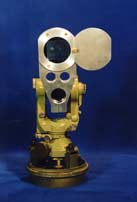The Large diffraction grating (Figure 1) has 1600 grooves/mm and is used with a bright light source (arc lamp) to obtain a spectacular continuous spectrum. The first and second order spectra are easily seen, while the third can be seen when the lights in the auditorium are dimmed.
Materials:
- Large reflective diffraction grating (Figure 1) has 1600 grooves/mm
- Small reflective diffraction grating
- 200 small slides with diffraction gratings (536 grooves/mm)
- Rod base and clamp assembly
Setup/demo:
This highly reflective diffraction grating is secured in a homemade holder with a protective lid and is attached to a Swiss-made survey protractor. Changing the angle of the protractor results in a spectrum shift. Placing a piece of black paper with a slot on the spectrum while shifting it can show to the students how monochromators work.
We also have 200 small slides with diffraction gratings (536 grooves/mm) that can be distributed between students to observe spectra from discharge tubes and other light sources.

